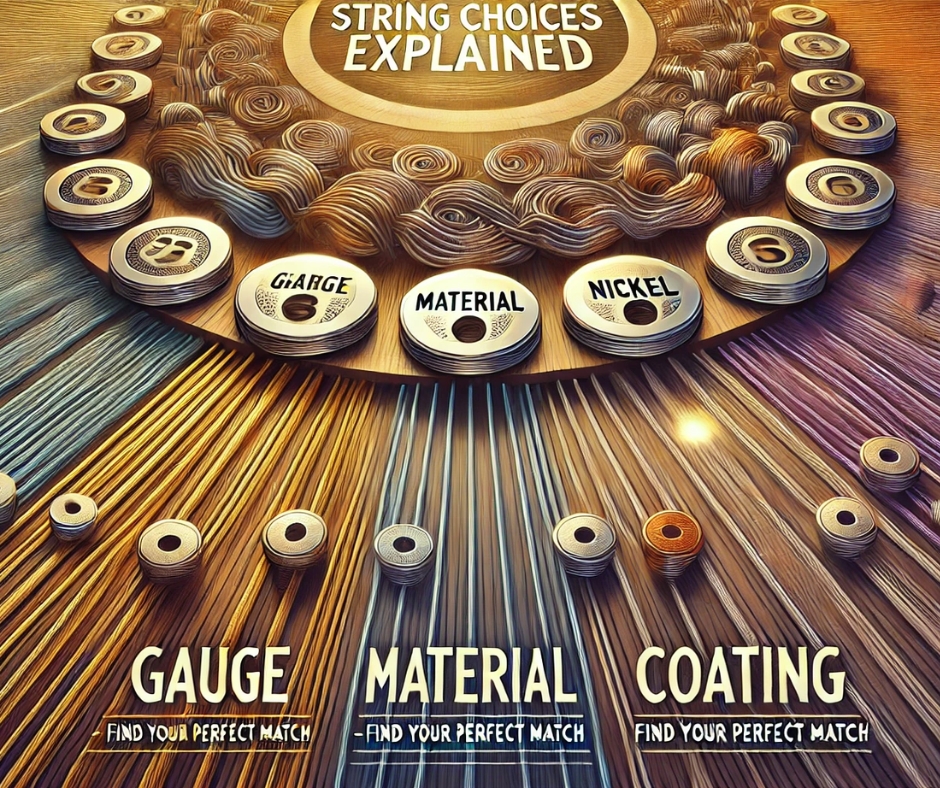Choosing the right strings for your guitar can be as important as selecting the guitar itself. The right strings can elevate your playing, enhance your tone, and ensure your instrument feels just right in your hands. In this guide, we’ll explore string gauge, material, and coating to help you make the best choice for your style and preferences.
What Is String Gauge and Why Does It Matter?
String gauge refers to the thickness of the strings, typically measured in thousandths of an inch. For example, a “.010” gauge string is 0.010 inches thick.
Common String Gauge Categories
• Extra Light (.008 – .010): Ideal for beginners or players who prefer a soft touch. Great for bending and fast play.
• Light (.011 – .012): A versatile choice for many genres, offering a balance between playability and tone.
• Medium (.013 – .015): Preferred by blues, rock, and jazz players who want a fuller, richer sound.
• Heavy (.016+): Suited for down-tuning and genres like metal or slide guitar, where volume and resonance are key.
Pro Tip: Consider your guitar type and playing style. Acoustic players often prefer medium to heavy gauges for projection, while electric guitarists might lean towards lighter gauges for ease of play.
String Materials and Their Impact on Tone
The material of your strings significantly affects their tone, feel, and durability. Here are the most common materials:
For Acoustic Guitars
• 80/20 Bronze: Bright and crisp tones, perfect for live performances. However, they tend to lose their brightness faster than other materials.
• Phosphor Bronze: Warm and rich tones with longer-lasting brightness. A favorite for many acoustic players.
• Silk and Steel: Softer tone and reduced tension, great for fingerstyle players or those seeking a mellow sound.
For Electric Guitars
• Nickel-Plated Steel: A balanced tone with a blend of brightness and warmth. Perfect for rock, blues, and pop.
• Pure Nickel: Warm, vintage-style tones with less brightness than nickel-plated options.
• Stainless Steel: Bright and durable, ideal for players looking for cutting tones and longevity.
For Classical Guitars
• Nylon Strings: Soft and warm tones, essential for classical and flamenco styles.
• Carbon Strings: Brighter and louder than nylon, with excellent projection.
Pro Tip: Match your string material to your preferred tone. Bright materials like stainless steel or 80/20 bronze suit aggressive styles, while warmer options like phosphor bronze or pure nickel enhance mellower genres.
The Role of String Coating
String coating is a modern innovation designed to enhance durability and playability. A thin polymer layer protects the string from dirt, sweat, and oil, prolonging its life.
Benefits of Coated Strings
• Longevity: Coated strings last significantly longer than uncoated ones, reducing the need for frequent changes.
• Consistency: The coating helps maintain tone quality over time.
• Smooth Feel: Coated strings often feel smoother under the fingers, reducing string noise.
Are There Drawbacks?
While coated strings are durable, some players feel they lack the natural brightness of uncoated strings. Additionally, they tend to cost more.
Pro Tip: If you’re a casual player or have acidic sweat that corrodes strings quickly, coated strings are an excellent investment.
How to Choose the Right Strings for Your Guitar
1. Identify Your Style: Are you strumming chords, playing intricate fingerstyle, or shredding solos? Your style dictates your needs.
2. Consider Your Guitar Type: Acoustic, electric, and classical guitars each require specific types of strings.
3. Experiment: Don’t hesitate to try different gauges, materials, and coatings to find your ideal combination.
4. Think About Maintenance: If you rarely change strings, coated options might save you time and effort.
How to Choose the Right Strings for Your Guitar
1. Identify Your Style: Are you strumming chords, playing intricate fingerstyle, or shredding solos? Your style dictates your needs.
2. Consider Your Guitar Type: Acoustic, electric, and classical guitars each require specific types of strings.
3. Experiment: Don’t hesitate to try different gauges, materials, and coatings to find your ideal combination.
4. Think About Maintenance: If you rarely change strings, coated options might save you time and effort.
Popular String Brands to Explore
• Ernie Ball: Known for their Slinky series, ideal for electric guitarists.
• D’Addario: Offers a wide range for all guitars, including coated and uncoated options.
• Elixir: Renowned for their long-lasting coated strings.
• Martin: A go-to for acoustic guitar players seeking rich tones.
• Savarez: A favorite for classical and flamenco guitarists.
FAQs About Guitar Strings
1. How often should I change my strings?
It depends on how often you play. Casual players might change strings every few months, while professionals may do so weekly or even daily during tours.
2. Can I mix string gauges?
Yes! Custom gauge sets can offer the best of both worlds, such as heavy bass strings for depth and lighter treble strings for playability.
3. Do strings affect tuning stability?
Absolutely. Higher-quality strings and proper installation significantly improve tuning stability.
Final Thoughts
Choosing the right guitar strings is a personal journey. By understanding string gauge, material, and coating, you can tailor your instrument’s feel and sound to your exact preferences. Whether you’re a beginner or a seasoned pro, investing time in experimenting with different strings will elevate your playing experience.
Have a favorite string brand or a unique tip? Share your thoughts in the comments below! And don’t forget to subscribe for more in-depth guitar tips and guides.







